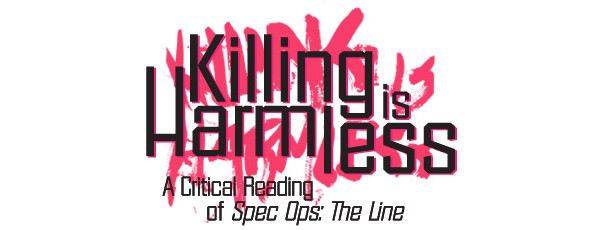
Every bit of symbolic criticism, if it goes on long enough, will eventually veer off into prescribing relevant meaning to content that didn’t intend it. I think I’ve made that rule up, but it feels like a thing that people would say. I’ve a personal gripe about this since it ruined an entire generation of schoolchildren’s appreciation of Catcher In The Rye. Sure, maybe the birds do represent Holden’s fleeting childhood, but sir, I don’t think the cab driver is his dad?
Brendan Keogh wrote a book that covers every moment in this year’s subversive shooter Spec Ops: The Line. It’s called Killing Is Harmless and it’s available for a very tiny bit of money. It’s a book that intends to act as an extra bit of content for people that have finished the game and want to read a little more into things they might have missed or another person’s experience playing through it.
 It differs from other explorations as, rather than trying to succinctly explain whether or not it’s a work of quality, Killing Is Harmless serves more to point out how the game uses techniques and plot to become a work of quality. If you haven’t played Spec Ops: The Line already it might be a little useless, plus it’s definitely liberal about discussing plot points in detail.
It differs from other explorations as, rather than trying to succinctly explain whether or not it’s a work of quality, Killing Is Harmless serves more to point out how the game uses techniques and plot to become a work of quality. If you haven’t played Spec Ops: The Line already it might be a little useless, plus it’s definitely liberal about discussing plot points in detail.
To start his 50,000 word submergence into the game’s heart Keogh admits that a lot of what he’s taking from it is likely going to be his own interpretation, one removed from the developer’s intentions and from what most players would even consider. He’s correct to do so, because although he captures in explicit detail every reason why Spec Ops: The Line was successful in creating one of gaming’s most worthwhile critiques of its own over-abundant tropes, he mixes up enough of it with his own, probably unsubstantiated, estimation.
Maybe that’s not a problem. Maybe he’s created a new form of Games Journalism, the long form voyage of personal understanding based on an incredible amount of thought and research. What he’s achieved in Killing Is Harmless is to chart his experience in detail and attempted to spell out how well the game achieves its goals.
Spec Ops: The Line is the result of publisher 2K asking developer Yager to create a rote 3rd-person, team-based cover shooter. What Yager did was exactly that. Spec Ops: The Line is not a “good game”, but is something that was not only self-reflective, but also player-reflective. Spec Ops: The Line is a game that examines what it means to play a shooter, be a character in a shooter and shoot a representation of a human in a shooter.
I reviewed the game for this site on its release, long before anyone had the slightest consideration that this would be any more than what it purported to be. I had a genesis probably unlike the majority of the audience. I had no reason to assume that this game would be special; there was no one telling me that eventually I would have my expectations blown wide open.
I played a shooter until it became more than a shooter.
Or, I guess, it didn’t.
Killing Is Harmless explains how that’s possible. It explains the game’s arc from performing entirely the same as the rest of the genre, to finally posing difficult questions to the player. Keogh explains and points out little things that you would have missed. The book is a celebration of the ideas that Yager attempt to put across in order to subtly get the point home.
Spec Ops: The Line is a game aware that it’s a game and aware that there’s a player. It’s telling a story that you’re implicit in, and it gives you tips about the content at almost every interval. Keogh shows off clues that suggest the game world might be less real than it initially seems, he points out the significance of birds, mannequins and even points out what in retrospect seems like the most obvious point of all, the significance of the lead character’s name.
 There are things that he gets “wrong”, though. It’s difficult to disregard his reading since the entire book is a collection of thoughts about what made this game special to him, based on his own journey through it. Killing Is Harmless succeeds as a book of criticism, but it’s also yes a book of criticism prescribing relevant meaning to content that didn’t intend it.
There are things that he gets “wrong”, though. It’s difficult to disregard his reading since the entire book is a collection of thoughts about what made this game special to him, based on his own journey through it. Killing Is Harmless succeeds as a book of criticism, but it’s also yes a book of criticism prescribing relevant meaning to content that didn’t intend it.
A point is brought up pretty effectively in a review of the book from Darius Kazemi. Keogh talks about a body being reflected in a mirror, but not being able to discover where it’s being reflected from. He suggests this is a comment on previous events, but it actually doesn’t look much like a body at all. It doesn’t really look like much of anything. It’s a clear instance of finding more relevance than actually exists in the initial text.
Even as Keogh delivers the mind-blowing reveal I mentioned before in explaining the character’s name, he undermines it at a point suggesting there’s even more to it. The character’s called Martin Walker; he poses the reading that, because M and W are the same when turned upside down, this can be read that this character’s world is being turned upside down. It’s a little reaching, but it’s his own take.
Killing is Harmless is a great companion piece to Spec Ops: The Line. A recommendable side purchase that does offer a great deal more depth and explanation, but requires knowledge that it doesn’t, and shouldn’t, line up with your own experience.
Killing is Harmless: Critical reading of Spec Ops: The Line is available now in ePub and PDF formats.
Every bit of symbolic criticism, if it goes on long enough, will eventually veer off into prescribing relevant meaning to content that didn’t intend it. I think I’ve made that rule up, but it feels like a thing that people would say. I’ve a personal gripe about this since it ruined an entire generation of schoolchildren’s appreciation of Catcher In The Rye. Sure, maybe the birds do represent Holden’s fleeting childhood, but sir, I don’t think the cab driver is his dad?
Brendan Keogh wrote a book that covers every moment in this year’s subversive shooter Spec Ops: The Line. It’s called Killing Is Harmless and it’s available for a very tiny bit of money. It’s a book that intends to act as an extra bit of content for people that have finished the game and want to read a little more into things they might have missed or another person’s experience playing through it.
To start his 50,000 word submergence into the game’s heart Keogh admits that a lot of what he’s taking from it is likely going to be his own interpretation, one removed from the developer’s intentions and from what most players would even consider. He’s correct to do so, because although he captures in explicit detail every reason why Spec Ops: The Line was successful in creating one of gaming’s most worthwhile critiques of its own over-abundant tropes, he mixes up enough of it with his own, probably unsubstantiated, estimation.
Maybe that’s not a problem. Maybe he’s created a new form of Games Journalism, the long form voyage of personal understanding based on an incredible amount of thought and research. What he’s achieved in Killing Is Harmless is to chart his experience in detail and attempted to spell out how well the game achieves its goals.
Spec Ops: The Line is the result of publisher 2K asking developer Yager to create a rote 3rd-person, team-based cover shooter. What Yager did was exactly that. Spec Ops: The Line is not a “good game”, but is something that was not only self-reflective, but also player-reflective. Spec Ops: The Line is a game that examines what it means to play a shooter, be a character in a shooter and shoot a representation of a human in a shooter.
I reviewed the game for this site on its release, long before anyone had the slightest consideration that this would be any more than what it purported to be. I had a genesis probably unlike the majority of the audience. I had no reason to assume that this game would be special; there was no one telling me that eventually I would have my expectations blown wide open.
I played a shooter until it became more than a shooter.
Or, I guess, it didn’t.
Killing Is Harmless explains how that’s possible. It explains the game’s arc from performing entirely the same as the rest of the genre, to finally posing difficult questions to the player. Keogh explains and points out little things that you would have missed. The book is a celebration of the ideas that Yager attempt to put across in order to subtly get the point home.
Spec Ops: The Line is a game aware that it’s a game and aware that there’s a player. It’s telling a story that you’re implicit in, and it gives you tips about the content at almost every interval. Keogh shows off clues that suggest the game world might be less real than it initially seems, he points out the significance of birds, mannequins and even points out what in retrospect seems like the most obvious point of all, the significance of the lead character’s name.
A point is brought up pretty effectively in a review of the book from Darius Kazemi. Keogh talks about a body being reflected in a mirror, but not being able to discover where it’s being reflected from. He suggests this is a comment on previous events, but it actually doesn’t look much like a body at all. It doesn’t really look like much of anything. It’s a clear instance of finding more relevance than actually exists in the initial text.
Even as Keogh delivers the mind-blowing reveal I mentioned before in explaining the character’s name, he undermines it at a point suggesting there’s even more to it. The character’s called Martin Walker; he poses the reading that, because M and W are the same when turned upside down, this can be read that this character’s world is being turned upside down. It’s a little reaching, but it’s his own take.
Killing is Harmless is a great companion piece to Spec Ops: The Line. A recommendable side purchase that does offer a great deal more depth and explanation, but requires knowledge that it doesn’t, and shouldn’t, line up with your own experience.
Killing is Harmless: Critical reading of Spec Ops: The Line is available now in ePub and PDF formats.
Share this: